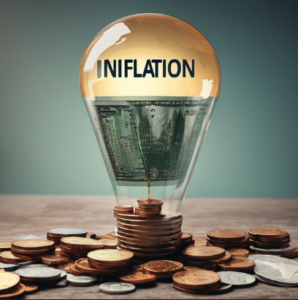
In a significant update issued by the Bank of Korea (BOK) in December 2024, the central bank made a notable statement about the future of inflation in South Korea. The BOK’s projection suggests that the country is unlikely to see the return of the “low-inflation” era in the next one to two years. This marks a shift in the expectations for economic conditions in the coming period, as inflationary pressures remain elevated across the globe and domestically. For businesses, investors, and consumers, this statement provides a clearer picture of what to expect in terms of inflation and the broader economic outlook in South Korea.
The statement has sparked widespread discussion, particularly as it challenges the assumption that the global economic recovery would lead to lower inflation rates in most countries. While there were hopes that inflation would gradually return to pre-pandemic levels, the Bank of Korea has highlighted a number of external and internal factors that are keeping inflationary pressures persistent. In this article, we will dive deep into the Bank of Korea’s position, the underlying factors contributing to inflation, and the outlook for South Korea’s economy over the next few years.
The Bank of Korea’s Outlook on Inflation
The Bank of Korea’s recent warning that the era of low inflation is unlikely to return soon sheds light on a range of complex economic forces at play, both within South Korea and on the global stage. The statement, made by BOK Governor Rhee Chang-yong, clarified that South Korea’s inflation would likely stay elevated for the next year or two, hovering above the country’s target rate of 2%. The central bank’s comments underscore the persistent nature of global inflation, with factors such as supply chain disruptions, energy price increases, and external trade risks influencing inflation levels in South Korea.
This new outlook indicates that inflation in South Korea, which had been rising sharply in 2024, is expected to remain above 2% through 2025. The Bank of Korea’s decision to revise its inflation forecast is largely attributed to the continued volatility in global markets, which have seen significant fluctuations in the prices of key commodities like oil, gas, and agricultural products. Additionally, the ongoing economic recovery following the COVID-19 pandemic has led to increased demand, which is further compounding supply-side challenges and driving up prices across various sectors.
External Influences on Inflation
One of the major factors influencing South Korea’s inflation trajectory is the state of the global economy. As one of the world’s most export-dependent economies, South Korea is highly sensitive to global market conditions. Global inflationary pressures have been persistent, with many countries, including the U.S. and major European nations, experiencing inflation rates higher than anticipated. These global pressures are not only a function of increased demand as economies rebound but are also deeply influenced by supply chain issues and geopolitical uncertainties.
For example, the price of crude oil has remained volatile in 2024, with increases in oil prices adding to transportation costs, which, in turn, affects the cost of goods and services across South Korea. As an importer of energy, the rising price of oil has added significant pressure to inflation, especially in industries reliant on energy-intensive production processes. Similarly, the prices of raw materials, such as metals and plastics, have been influenced by supply chain disruptions and the geopolitical tensions that have emerged in different parts of the world.
The Bank of Korea has acknowledged that the uncertainty in global markets will likely continue to keep inflation at elevated levels for the foreseeable future. This external volatility, combined with domestic factors, makes it difficult for the bank to predict a quick return to low inflation.
Domestic Factors Affecting Inflation
On the domestic front, South Korea faces several factors contributing to inflationary pressures. Rising labor costs and public utility price hikes are among the key contributors. In particular, the country has seen an increase in the cost of essential services, including electricity and natural gas, as the government adjusts its pricing policies to reflect market conditions. These hikes, in turn, have a cascading effect on household budgets, leading to higher costs for families and businesses alike.
In addition to utility price increases, South Korea’s domestic food prices have risen sharply. The agriculture sector in South Korea has been severely impacted by climate conditions, affecting crop yields and leading to higher food prices. As the cost of production rises, these increases are reflected in consumer prices, further contributing to the overall inflation rate. These domestic pressures are compounded by the global food price inflation that has been seen worldwide, making it harder for South Korean consumers to shield themselves from rising costs.
The Bank of Korea’s forecast for inflation also takes into account demographic changes within the country. South Korea has one of the fastest-aging populations in the world, and this demographic shift is expected to increase the demand for healthcare services, placing additional pressure on inflation. With fewer workers in the economy, wage growth could slow, potentially leading to slower productivity growth as well.
Economic Growth Amid Inflationary Pressures
Despite the persistent inflationary pressures, the Bank of Korea has maintained a relatively optimistic outlook for economic growth in South Korea over the next few years. According to the bank’s projections, South Korea’s economy is expected to grow at a rate of 1.8% to 2.0% in 2025, reflecting moderate growth despite inflationary pressures. This growth is attributed to a combination of factors, including South Korea’s technological prowess, strong export performance, and ongoing government investments in infrastructure.
While inflation has a direct impact on domestic spending power, South Korea’s economy is expected to benefit from strong exports, particularly in the semiconductor, automotive, and electronics sectors. These industries continue to be competitive on the global market, providing a steady source of income and boosting the overall economy. Moreover, South Korea’s government has been proactive in investing in infrastructure projects, which is expected to further support the economy and job creation.
Additionally, the government’s focus on innovation and new technology adoption, such as artificial intelligence and green energy technologies, is expected to contribute to economic expansion. While inflationary pressures may dampen some of the growth potential in consumer spending, South Korea’s industrial and technological sectors provide a solid foundation for continued economic stability.
However, despite the optimistic growth projections, the Bank of Korea has also cautioned that global uncertainties, such as trade tensions and geopolitical risks, could affect the nation’s ability to achieve its growth targets. The complex nature of the global economy, coupled with ongoing inflation, means that South Korea will face a balancing act as it tries to navigate both domestic and international challenges.
The Role of the Bank of Korea’s Monetary Policy
The Bank of Korea plays a central role in managing inflation through its monetary policy. Over the course of 2024, the BOK has been gradually raising interest rates in response to rising inflation, in an attempt to control the pace of price increases. However, the BOK is also aware of the risks associated with overly aggressive tightening of monetary policy, as this could stifle economic growth.
Currently, the BOK’s benchmark interest rate stands at 3.00%, a rate that was increased earlier in the year as part of the bank’s efforts to curb inflation. While the bank has signaled that it will maintain this rate for the time being, it has also stated that it is prepared to adjust monetary policy depending on the evolving economic situation. The BOK aims to strike a delicate balance between controlling inflation and supporting economic growth, ensuring that price pressures do not spiral out of control while not pushing the economy into recession.
As inflation remains a key concern, the BOK’s strategy will likely involve a more cautious approach to rate changes in the coming year. The central bank will continue to monitor inflation closely, making adjustments as needed to keep inflation within the targeted range while not stifling the recovery process in key sectors of the economy.
The Global Inflationary Landscape
South Korea’s inflationary trends are also shaped by global economic developments. The inflationary environment is not unique to South Korea—many other advanced economies are grappling with similarly high inflation rates, driven by similar supply-side disruptions and rising energy costs. For instance, the United States has experienced persistent inflation in 2024, with rising fuel prices and supply chain bottlenecks contributing to increased costs across various sectors.
These global pressures have a direct impact on South Korea, particularly in the manufacturing and export sectors. As global demand continues to rise, the cost of raw materials and energy is expected to remain high, putting upward pressure on South Korean prices. Moreover, changes in the exchange rate of the South Korean won against major currencies like the U.S. dollar can further affect import prices, influencing inflation.
The interconnectedness of the global economy means that South Korea will continue to feel the effects of global inflationary trends for the foreseeable future. Whether it is through rising energy prices, supply chain disruptions, or currency fluctuations, the forces driving inflation are not confined to South Korea’s borders. As such, the BOK’s strategy will need to account for these external factors as it attempts to manage inflation domestically.
Impact on Consumers and Businesses
The impact of persistent inflation is felt most directly by consumers and businesses. For consumers, rising prices lead to a reduction in purchasing power, as the cost of everyday goods and services increases. This can particularly affect lower-income households, who may struggle to afford basic necessities. With inflation expected to remain elevated, South Korean households will likely experience a squeeze on their disposable incomes, making it harder to maintain the same level of consumption as in previous years.
For businesses, the situation is equally challenging. Higher costs of production, driven by increased energy prices, raw material shortages, and rising labor costs, are likely to lead to higher prices for finished goods and services. This puts pressure on businesses to pass those costs onto consumers, which could further fuel inflation in the economy.
While the government has implemented various relief measures to assist struggling households, such as subsidies for energy costs and public transport, these measures may not fully offset the rising costs of living. As such, both consumers and businesses will need to adapt to the reality of a prolonged period of inflation.
In conclusion, the Bank of Korea’s recent statement about the future of inflation is a reminder that inflationary pressures are expected to remain a significant issue in the global and South Korean economies for the next few years. While the outlook for economic growth remains cautiously optimistic, persistent inflation continues to create challenges for both consumers and businesses. With global uncertainties, supply chain disruptions, and rising energy prices continuing to shape the inflationary landscape, it is clear that the low-inflation era is unlikely to return anytime soon.
As the Bank of Korea continues to adjust its monetary policy in response to these economic conditions, South Korea will need to navigate the complexities of global inflation, ensuring that economic stability and growth are not derailed by rising prices. The next year or two will be crucial in shaping South Korea’s economic trajectory, with inflation management being a central issue for policymakers. As businesses, consumers, and governments adapt to these new realities, the long-term impact of inflation will likely continue to influence economic decision-making well into the future.
FAQ Section
Q1: Why is inflation expected to remain high in South Korea for the next few years?
Inflation is expected to remain elevated due to global economic uncertainties, including rising energy prices, supply chain disruptions, and geopolitical risks. Additionally, domestic factors like rising labor costs and food price hikes contribute to inflationary pressures.
Q2: How does global inflation affect South Korea’s economy?
South Korea’s economy is highly export-dependent, meaning global inflationary trends, particularly in raw material prices, energy, and transportation, impact the cost of production and exports, which directly feeds into domestic inflation.
Q3: What measures is the Bank of Korea taking to control inflation?
The Bank of Korea has raised interest rates to curb inflationary pressures, and it continues to monitor inflation closely to balance growth and price stability. However, global and domestic factors continue to complicate inflation management.
Feel free to check out our other website at : https://synergypublish.com


